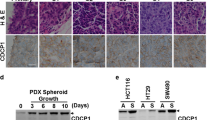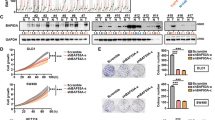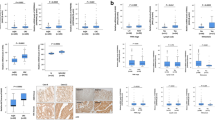Abstract
Misregulation of the canonical Wnt/β-catenin pathway and aberrant activation of Wnt signaling target genes are common in colorectal cancer (CRC) and contribute to cancer progression. Altered expression of human enhancer of filamentation 1 (HEF1; also known as NEDD9 or Cas-L) has been implicated in progression of melanoma, breast, and CRC. However, the regulation of HEF1 and the role of HEF1 in CRC tumorigenesis are not fully understood. We here identify HEF1 as a novel Wnt signaling target. The expression of HEF1 was upregulated by Wnt-3a, β-catenin, and Dvl2 in a dose-dependent manner, and was suppressed following β-catenin downregulation by shRNA. In addition, elevated HEF1 mRNA and protein levels were observed in CRC cell lines and primary tumor tissues, as well as in the colon and adenoma polyps of ApcMin/+ mice. Moreover, HEF1 levels in human colorectal tumor tissues increased with the tumor grade. Chromatin immunoprecipitation (ChIP) assays and promoter analyses revealed three functional T-cell factor (TCF)-binding sites in the promoter of HEF1 responsible for HEF1 induction by Wnt signaling. Ectopic expression of HEF1 increased cell proliferation and colony formation, while downregulation of HEF1 in SW480 cells by shRNA had the opposite effects and inhibited the xenograft tumor growth. Furthermore, overexpression of HEF1 in SW480 cells promoted cell migration and invasion. Together, our results determined a novel role of HEF1 as a mediator of the canonical Wnt/β-catenin signaling pathway for cell proliferation, migration, and tumorigenesis, as well as an important player in colorectal tumorigenesis and progression. HEF1 may represent an attractive candidate for drug targeting in CRC.
This is a preview of subscription content, access via your institution
Access options
Subscribe to this journal
Receive 50 print issues and online access
$259.00 per year
only $5.18 per issue
Buy this article
- Purchase on Springer Link
- Instant access to full article PDF
Prices may be subject to local taxes which are calculated during checkout





Similar content being viewed by others
References
Aarskog NK, Vedeler CA . (2000). Real-time quantitative polymerase chain reaction. A new method that detects both the peripheral myelin protein 22 duplication in Charcot-Marie-Tooth type 1A disease and the peripheral myelin protein 22 deletion in hereditary neuropathy with liability to pressure palsies. Hum Genet 107: 494–498.
Barker N, Clevers H . (2006). Mining the Wnt pathway for cancer therapeutics. Nat Rev Drug Discov 5: 997–1014.
Batistatou A, Charalabopoulos AK, Scopa CD, Nakanishi Y, Kappas A, Hirohashi S et al. (2006). Expression patterns of dysadherin and E-cadherin in lymph node metastases of colorectal carcinoma. Virchows Arch 448: 763–767.
Behrens J, von Kries JP, Kuhl M, Bruhn L, Wedlich D, Grosschedl R et al. (1996). Functional interaction of beta-catenin with the transcription factor LEF-1. Nature 382: 638–642.
Boyer LA, Lee TI, Cole MF, Johnstone SE, Levine SS, Zucker JP et al. (2005). Core transcriptional regulatory circuitry in human embryonic stem cells. Cell 122: 947–956.
Donninger H, Bonome T, Radonovich M, Pise-Masison CA, Brady J, Shih JH et al. (2004). Whole genome expression profiling of advance stage papillary serous ovarian cancer reveals activated pathways. Oncogene 23: 8065–8077.
Easwaran V, Lee SH, Inge L, Guo L, Goldbeck C, Garrett E et al. (2003). beta-Catenin regulates vascular endothelial growth factor expression in colon cancer. Cancer Res 63: 3145–3153.
Easwaran V, Pishvaian M, Salimuddin, Byers S . (1999). Cross-regulation of beta-catenin-LEF/TCF and retinoid signaling pathways. Curr Biol 9: 1415–1418.
Faivre EJ, Lange CA . (2007). Progesterone receptors upregulate Wnt-1 to induce epidermal growth factor receptor transactivation and c-Src-dependent sustained activation of Erk1/2 mitogen-activated protein kinase in breast cancer cells. Mol Cell Biol 27: 466–480.
Fashena SJ, Einarson MB, O'eill GM, Patriotis C, Golemis EA . (2002). Dissection of HEF1-dependent functions in motility and transcriptional regulation. J Cell Sci 115: 99–111.
Fritzmann J, Morkel M, Besser D, Budczies J, Kosel F, Brembeck FH et al. (2009). A colorectal cancer expression profile that includes transforming growth factor beta inhibitor BAMBI predicts metastatic potential. Gastroenterology 137: 165–175.
Fujino H, West KA, Regan JW . (2002). Phosphorylation of glycogen synthase kinase-3 and stimulation of T-cell factor signaling following activation of EP2 and EP4 prostanoid receptors by prostaglandin E2. J Biol Chem 277: 2614–2619.
He TC, Sparks AB, Rago C, Hermeking H, Zawel L, da Costa LT et al. (1998). Identification of c-MYC as a target of the APC pathway. Science 281: 1509–1512.
Izumchenko E, Singh MK, Plotnikova OV, Tikhmyanova N, Little JL, Serebriiskii IG et al. (2009). NEDD9 promotes oncogenic signaling in mammary tumor development. Cancer Res 69: 7198–7206.
Ji H, Ramsey MR, Hayes DN, Fan C, McNamara K, Kozlowski P et al. (2007). LKB1 modulates lung cancer differentiation and metastasis. Nature 448: 807–810.
Kim M, Gans JD, Nogueira C, Wang A, Paik JH, Feng B et al. (2006). Comparative oncogenomics identifies NEDD9 as a melanoma metastasis gene. Cell 125: 1269–1281.
Kim PJ, Plescia J, Clevers H, Fearon ER, Altieri DC . (2003). Survivin and molecular pathogenesis of colorectal cancer. Lancet 362: 205–209.
Labbe E, Letamendia A, Attisano L . (2000). Association of Smads with lymphoid enhancer binding factor 1/T cell-specific factor mediates cooperative signaling by the transforming growth factor-beta and wnt pathways. Proc Natl Acad Sci USA 97: 8358–8363.
Law SF, O'eill GM, Fashena SJ, Einarson MB, Golemis EA . (2000). The docking protein HEF1 is an apoptotic mediator at focal adhesion sites. Mol Cell Biol 20: 5184–5195.
Leone A, Flatow U, VanHoutte K, Steeg PS . (1993). Transfection of human nm23-H1 into the human MDA-MB-435 breast carcinoma cell line: effects on tumor metastatic potential, colonization and enzymatic activity. Oncogene 8: 2325–2333.
Letamendia A, Labbe E, Attisano L . (2001). Transcriptional regulation by Smads: crosstalk between the TGF-beta and Wnt pathways. J Bone Joint Surg Am 83-A (Suppl 1): S31–S39.
Li YC, Park MJ, Ye SK, Kim CW, Kim YN . (2006). Elevated levels of cholesterol-rich lipid rafts in cancer cells are correlated with apoptosis sensitivity induced by cholesterol-depleting agents. Am J Pathol 168: 1107–1118; quiz 1404–1405.
Liu T, Li R, Pan T, Liu D, Petersen RB, Wong BS et al. (2002). Intercellular transfer of the cellular prion protein. J Biol Chem 277: 47671–47678.
Liu W, Dong X, Mai M, Seelan RS, Taniguchi K, Krishnadath KK et al. (2000). Mutations in AXIN2 cause colorectal cancer with defective mismatch repair by activating beta-catenin/TCF signalling. Nat Genet 26: 146–147.
Lu D, Cottam HB, Corr M, Carson DA . (2005). Repression of beta-catenin function in malignant cells by nonsteroidal antiinflammatory drugs. Proc Natl Acad Sci USA 102: 18567–18571.
Lucas Jr JT, Salimath BP, Slomiany MG, Rosenzweig SA . (2010). Regulation of invasive behavior by vascular endothelial growth factor is HEF1-dependent. Oncogene 29: 4449–4459.
Ma H, Nguyen C, Lee KS, Kahn M . (2005). Differential roles for the coactivators CBP and p300 on TCF/beta-catenin-mediated survivin gene expression. Oncogene 24: 3619–3631.
Merrill RA, See AW, Wertheim ML, Clagett-Dame M . (2004). Crk-associated substrate (Cas) family member, NEDD9, is regulated in human neuroblastoma cells and in the embryonic hindbrain by all-trans retinoic acid. Dev Dyn 231: 564–575.
Morin PJ, Sparks AB, Korinek V, Barker N, Clevers H, Vogelstein B et al. (1997). Activation of beta-catenin-Tcf signaling in colon cancer by mutations in beta-catenin or APC. Science 275: 1787–1790.
Natarajan M, Stewart JE, Golemis EA, Pugacheva EN, Alexandropoulos K, Cox BD et al. (2006). HEF1 is a necessary and specific downstream effector of FAK that promotes the migration of glioblastoma cells. Oncogene 25: 1721–1732.
Novak A, Dedhar S . (1999). Signaling through beta-catenin and Lef/Tcf. Cell Mol Life Sci 56: 523–537.
O'Neill GM, Fashena SJ, Golemis EA . (2000). Integrin signalling: a new Cas(t) of characters enters the stage. Trends Cell Biol 10: 111–119.
Richer JK, Jacobsen BM, Manning NG, Abel MG, Wolf DM, Horwitz KB . (2002). Differential gene regulation by the two progesterone receptor isoforms in human breast cancer cells. J Biol Chem 277: 5209–5218.
Satoh S, Daigo Y, Furukawa Y, Kato T, Miwa N, Nishiwaki T et al. (2000). AXIN1 mutations in hepatocellular carcinomas, and growth suppression in cancer cells by virus-mediated transfer of AXIN1. Nat Genet 24: 245–250.
Segditsas S, Tomlinson I . (2006). Colorectal cancer and genetic alterations in the Wnt pathway. Oncogene 25: 7531–7537.
Shao J, Jung C, Liu C, Sheng H . (2005). Prostaglandin E2 Stimulates the beta-catenin/T cell factor-dependent transcription in colon cancer. J Biol Chem 280: 26565–26572.
Spencer VA, Sun JM, Li L, Davie JR . (2003). Chromatin immunoprecipitation: a tool for studying histone acetylation and transcription factor binding. Methods 31: 67–75.
Tetsu O, McCormick F . (1999). Beta-catenin regulates expression of cyclin D1 in colon carcinoma cells. Nature 398: 422–426.
van Seventer GA, Salmen HJ, Law SF, O'Neill GM, Mullen MM, Franz AM et al. (2001). Focal adhesion kinase regulates beta1 integrin-dependent T cell migration through an HEF1 effector pathway. Eur J Immunol 31: 1417–1427.
Velmurugan B, Singh RP, Kaul N, Agarwal R, Agarwal C . (2010). Dietary feeding of grape seed extract prevents intestinal tumorigenesis in APCmin/+ mice. Neoplasia 12: 95–102.
Xia D, Holla VR, Wang D, Menter DG, DuBois RN . (2010). HEF1 is a crucial mediator of the proliferative effects of prostaglandin E(2) on colon cancer cells. Cancer Res 70: 824–831.
Yasuhara R, Yuasa T, Williams JA, Byers SW, Shah S, Pacifici M et al (2009). Wnt/beta-catenin and retinoic acid receptor signaling pathways interact to regulate chondrocyte function and matrix turnover. J Biol Chem 285: 317–327.
Yook JI, Li XY, Ota I, Hu C, Kim HS, Kim NH et al. (2006). A Wnt-Axin2-GSK3beta cascade regulates Snail1 activity in breast cancer cells. Nat Cell Biol 8: 1398–1406.
Zhai Y, Wu R, Schwartz DR, Darrah D, Reed H, Kolligs FT et al. (2002). Role of beta-catenin/T-cell factor-regulated genes in ovarian endometrioid adenocarcinomas. Am J Pathol 160: 1229–1238.
Zheng M, McKeown-Longo PJ . (2002). Regulation of HEF1 expression and phosphorylation by TGF-beta 1 and cell adhesion. J Biol Chem 277: 39599–39608.
Acknowledgements
We thank Dr Minjung Kim and Dr Lynda Chin (Harvard Medical School) for providing the shRNA-targeting HEF1. This study is supported by the funding from Louisiana Cancer Research Consortium (to WL). EAG is supported by NIH R01s CA63366 and CA113342, and by NIH core grant CA06927 (to Fox Chase Cancer Center).
Author information
Authors and Affiliations
Corresponding author
Ethics declarations
Competing interests
The authors declare no conflict of interest.
Additional information
Supplementary Information accompanies the paper on the Oncogene website
Rights and permissions
About this article
Cite this article
Li, Y., Bavarva, J., Wang, Z. et al. HEF1, a novel target of Wnt signaling, promotes colonic cell migration and cancer progression. Oncogene 30, 2633–2643 (2011). https://doi.org/10.1038/onc.2010.632
Received:
Revised:
Accepted:
Published:
Issue Date:
DOI: https://doi.org/10.1038/onc.2010.632
Keywords
This article is cited by
-
Prognostic Significances of NEDD-9 and FOXL-1 Expression in Intestinal Type Gastric Carcinoma: an Immunohistochemical Study
Journal of Gastrointestinal Cancer (2021)
-
SOX9 is a dose-dependent metastatic fate determinant in melanoma
Journal of Experimental & Clinical Cancer Research (2019)
-
miR-18a counteracts AKT and ERK activation to inhibit the proliferation of pancreatic progenitor cells
Scientific Reports (2017)
-
Multiple oncogenic roles of nuclear β-catenin
Journal of Biosciences (2017)
-
Actin polymerization‐dependent activation of Cas‐L promotes immunological synapse stability
Immunology & Cell Biology (2016)



